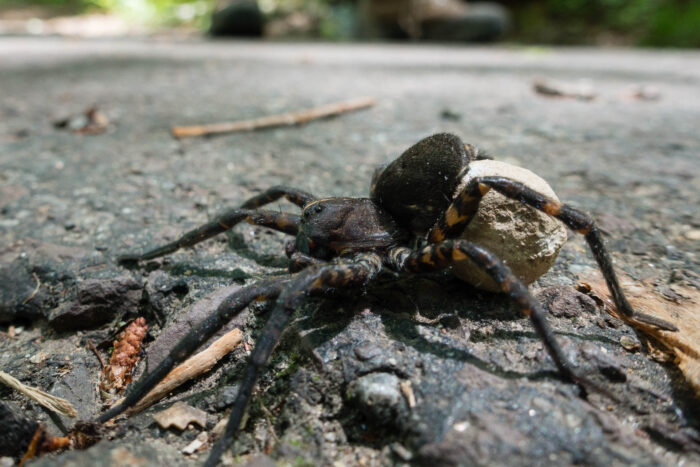Wolf Spider
Family: Lycosidae
Wolf spiders are the most common spiders around the world and 200 species live in the United States. Wolf spiders are black or brown with long, thin legs.
This section shows one large critter image at a time. Use the thumbnails that follow to select a specific image to display here.

This gallery contains a grid of small thumbnails. Selecting a thumbnail will change the main image in the preceding section.
Appearance
Wolf spiders are black or brown and have light and dark lengthwise stripes across their bodies. They have three rows of dark eyes in sets of four, two and two, with the first row being the smallest. There are over 2,300 species of wolf spider in the world.
Wolf spiders have long, thin legs and often have lines or a splotchy pattern on their body. Females have larger bodies than males, 5.1 to 6.4 millimeters compared with 4.3 to 5 millimeters in length. Females can sometimes be seen carrying young on their back. Males have white hairs on part of their legs.
Feeding
Wolf spiders are carnivorous. It will inject its prey with venom and suck out its fluids. Prey includes insects like grasshoppers and ants, insect eggs and other spiders.
Predators
Predators include small mammals, reptiles and amphibians, as well as spider-eating birds.
Reproduction and life cycle
Wolf spiders mate in the spring. On sunny days, males will perform courtship dances to attract females (though if they’re not careful, they may become the female’s prey instead of her mate). After mating, the eggs are laid and gathered into a green egg sac.
The mother carries the sac on her back until the eggs are ready to hatch, at which time she helps open the sac so the babies can escape. There may be more than 100 babies that hatch. The young will all climb on her back in layers and stay there for the next week before becoming independent.
Did you know?
- There are around 2,300 species of wolf spider in the world.
- Wolf spiders don’t create shelters or webs—they roam over the ground through low vegetation.
- Wolf spiders are the most common type of spider globally.
Sources and additional information
- Pardosa milvina – Animal Diversity Web, University of Michigan
- Common Spiders of Maryland – Maryland Department of Natural Resources
- Family Lycosidae – Bug Guide
